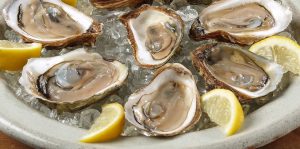By: Jon Kelvey Contact Reporter, Carroll County Times
October 10, 2015

It was a refreshingly cool autumn afternoon in Westminster, where the trees had changed color, as if by magic to mark the season, colorful canopies dotted downtown, and the breeze carried the faint aroma of, well, the bay.
This was the first-ever Downtown Westminster Oyster Stroll on Saturday, a culinary bivalve bonanza with its roots in Chesapeake Bay conservation, and people from every walk of life and every level of oyster eating experience turned out to slurp the shellfish raw, seasoned, or cooked. Shucking stations were located at strategic points along Main Street.
“It was slimy,” said 7-year-old McKenzie Cleaver, moments after eating her first raw oyster. She made a face, described its flavor as “salty” and quickly decided that she would like to eat one again. It must be a family trait, according to her mother, Chris Cleaver, of Westminster by way of Chincoteague.
“We just really love oysters,” Chris Cleaver said. “This was cool, this was a really different event, so it was nice to have something different to go to.”
A nose for oysters had also brought out friends Mike Ritchey, Bill Shamer and Denny Broderick, who commented on the wide variety of oysters available.
“I love oysters. I try to get them whenever I can, and this is just like an oyster lover’s heaven,” Broderick said. “They really brought the community together here for all this — they ordered great weather.”
“Maybe our wives will have a comment tomorrow, too,” Shamer added, alluding to certain folk wisdom surrounding the oyster’s nutritional value.
The Oyster Stroll also had great value for the Chesapeake Bay, according to Mike Wissel, vice president of the Coastal Conservation Association Central Region Chapter.
“They are filtering organisms, they provide structure, they provide habitat. Really the bay’s ecosystem begins and ends with the oyster,” Wissel said. “One oyster can filter up to 50 gallons of water a day.”
Oysters naturally grow in beds on the sea floor that build up over time, Wissel said, creating a three-dimensional structure that cleans the water and provides habitat for crustaceans; shrimp; feeder fish; and, eventually, larger sport fish such as striped bass.
Those natural beds were destroyed over time by overfishing, beginning in the 1800s, according to Gregory Bartles, a former lieutenant with and now agency historian for the Maryland Natural Resources Police. As early as 1820, he said, wealthy dredge boat captains from New England who had depleted their region’s stock of oysters came south to exploit the Chesapeake while it was still rich with shellfish.
“The local watermen felt that their livelihood was being threatened by this harvesting by dredge boats,” he said. “There were a lot of conflicts. Everybody had a gun. Everybody shot at each other, the bigger boats would run down the smaller boats. People drowned all the time.”
Laws were passed to prevent dredging and a police force was created to enforce them — Bartles had come to the Oyster Stroll with a cannon that had once been mounted on a ship used to combat “oyster pirates” — but dredging was allowed with a license after 1865, Bartles said.
Today, according to Wissel, the bay is estimated to contain just 1 percent of the oyster stock it once did, and that is a source of motivation for his CCA chapter.
“We wanted to do something, and not just raise money, but something tangible we could really hang our hat on in terms of a habitat project,” Wissel said. “We have a couple of high school kids [in our chapter] that came up with the idea of let’s start to recycle oyster shells in the area, and nobody had really done that out here because we are so far away from the bay.”
The CCA began collecting oyster shells from local restaurants about nine months ago, according to Wissel, with a goal of collecting a total of 200,000 shells. Shells can be seeded with oyster larvae, or “spat,” and returned to the bay to jump-start the formation of a new oyster bed, a living reef.
“Every shell that you put new spat on can become the basis to form 10 new oysters, so it’s exponential the kind of growth you can have occur,” Wissel said. “These 200,000 shells will serve as the building blocks for 2 million new oysters. We are looking to sink our first reef by mid to end of next year, depending on a variety of factors.”
One important factor will be the additional 12,000 to 13,000 oysters Wissel ordered for the Oyster Stroll — every oyster a stroller enjoyed will now become two halves, each of which can support 10 new oysters.
The two high school students who got the oyster ball rolling, Westminster High School junior Summer Miles and North Carroll High School senior Brett Hackett, were also responsible for bringing the shell recycling program to its festive focal point with the Oyster Stroll. They approached Maggie’s Restaurant owner Jim Breuer about doing an event.
“The Coastal Coalition Association came up to me and wanted to do an event in my back dining room. I said, ‘Rather than just doing something here, let’s see if we can get the city involved and basically create a downtown oyster festival,’ ” he said. “This is how it all started.”
Hackett and Miles hope it is just the beginning.
“My hometown city created an event to support the reef that I have a part in creating. It is so rewarding to see the change that one idea and some initiative can make,” Miles said. “I definitely plan on continuing this type of work. Hopefully I will be able to spark someone else’s interest now, and this project will continue to grow — as well as the wild oyster population.”
jon.kelvey@carrollcountytimes.com
410-857-3317
twitter.com/CCT_Health
